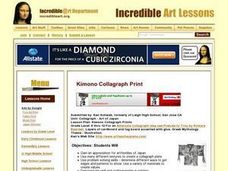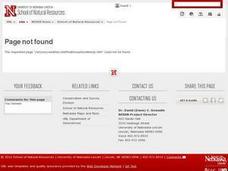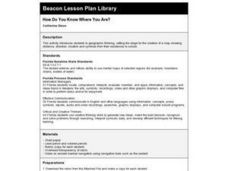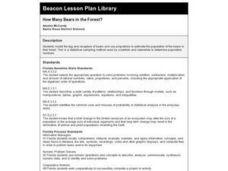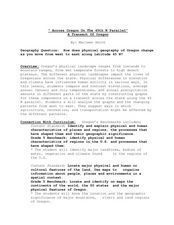Curated OER
Metric Conversions
Students translate a mathematical idea from one form to another. They compare and convert a given measurement to another unit within the same measurement system.
Curated OER
Kimono Collagraph Prints
Students gain an appreciation for art/textiles for Japan. They use different textures to create a collagraph plate. They hand color a print with colored pencil to create interest.
Curated OER
Metric Conversions
Students practice the fundamentals of converting metric measurements. They translate a mathematical idea from one form to another and compare and convert a given measurement to another unit within the same measurement system. Students...
Curated OER
Project Geode
Students predict the appearance of a geode's internal structure based on its mass and density. They form a hypothesis based on the data they collect. They also identify common minerals found in Illinois.
Curated OER
How to Read a Thermometer
Students' temperature is measured using an instrument called a thermometer.
Curated OER
Looking Inside Cells
Seventh graders examine the functions and roles of membranes in cells. They discover the differences between plant and animal cells.
Curated OER
Earth's Atmosphere and Temperature
Students explore the layers of earth's atmosphere and conduct an experiment to identify carbon dioxide. They construct models using styrofoam to represent molecules in the atmosphere's layers. To discover how sunlight efffects...
Curated OER
Taste Buds
Students sample several sweet, sour, bitter and salty foods. They determine what part of their tongue tasted each flavor.
Curated OER
Pearl Harbor-Japanese View-U.S. View
In this learning exercise on Pearl Harbor, students read short passages about both the Japanese viewpoint and the viewpoint of the U.S. Worksheet included activity suggestions for 4-6 grades.
Curated OER
China
Students explore the geography, culture and history of China. As a class, they discuss historical contributions to China, Confucius, and geographic features of the country. Pupils use the internet to answer questions about China.
Curated OER
How Do You Know Where You Are?
Seventh graders are introduced to geographic thinking, setting the stage for the creation of a map showing distance, direction, location and symbols from their residences to school.
Curated OER
Climate and Topography, What Is the Connection?
Fourth graders study Neumann's world continent map and explore topography and climate.
Curated OER
Metropolitan Areas in the USA
Fifth graders explore why people live in certain regions of the United States. They investigate information on specific metropolitan areas such as temperature, population, natural resources, precipitation and landforms. In groups, 5th...
Curated OER
Geography and World History
Students build off of their current knowledge of geography and world history, while being introduced to new concepts and ideas.
Curated OER
Memo from the Governor
Fourth graders inquire about the history of Florida's capital after receiving a mock memo from the governor.
Curated OER
What's the Problem?
Fourth graders redefine the problem of Where's the Heart of Florida? and begin to formulate possible solutions using graphic organizers.
Curated OER
How Many Bears in the Forest?
Third graders model the tag and recapture of bears and use proportions to estimate the population of the bears in their forest. This is a statistical sampling method used by scientists and naturalists to determine population numbers.
Curated OER
A River Runs Through Our Town
Students conduct an interview with a town resident, asking them to describe the history, use, and their memories of a river common to their community. They create a drawing of the river using information from the interview, and write...
Curated OER
Harmful Effects of Acid Rain
Students participate in an experiment to become aware of the harmful effects of an acidic solution -- acid rain.
Curated OER
"Across Oregon On The 45th N Parallel" A Transect of Oregon
Students explore the physical geography of Oregon. In groups, students collect weather and elevation information on Oregon. They organize the data and create maps and graphs of the information. Afterward, students compare the...
Curated OER
The Maggie B.
Students are read the book "The Maggie B.". Using the text, they try to name the locations mentioned. They use a map to name all the oceans and seas and discuss the characteristics of each. They color a map worksheet to keep with them...
Curated OER
Book: Spain
Learners, after reading Chapter One in the book, "Spain," design and re-create the political boundaries as well as the physical features of nation of Spain. They utilize play-doh or salt dough to illustrate and create their three...
Curated OER
Mystery Creek
Fourth graders are introduced to the Riparian Ecosystem. They define the following terms: riparian and riparian ecosystem. Students take a trip to the creek, where they make observations about the environment around them. They are...
Curated OER
Lakes and Ponds
Students describe and recognize the difference between a lake and a pond. They name six ways in which a lake or pond can be formed. They describe the importance and act of evaporation on a waterway.



